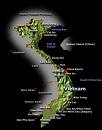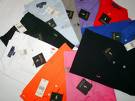Semester
at
Sea Fall
2006 Voyage 
- Corey's Home Page
- My bio
- "Crossing the Globe" Comparative Migration Project
- Transnational Restaurants
- Colonial Legacy in Hong
Kong
- Commercial
Asylum
in Vietnam
- Domestic Refugees in Burma
- Academic Links
- EU Integration
- Open Letter
Commercial Asylum in Vietnam

by Corey
Signs of migration are slightly more hidden amidst the Vietnamese landscape, at least in the sense that we have thus far explored. The absence of corporate migration may be more noteworthy in many respects, particularly in regards to the American monster McDonald’s. Personal narratives of strict government control exemplify the attitude of the government and are indicative of a time and place in Vietnamese history.
McDonalds is not
present in the Ho Chi Minh horizon; golden arches do not
riddle the
landscape. The average
income simply
will not allow for the McDonalds to secure a foothold in
this region of
However, the
images branded amidst mimic products have crossed many
boundaries,
ranging from
the presence of Puma, Polo, Diesel,  original and thus,
are worth less. In a nation
built on the
backs of motorbikes,
a wide range of migration occurs in the omnipresent
infiltration of
both
Japanese and Chinese motorcycles. Japanese
bikes
were rumored to cost between 1 and 6
thousand US dollars
while Chinese bikes may cost a mere 300 dollars. Chinese
DVD’s flood the tourist nooks, as
bootleg
original and thus,
are worth less. In a nation
built on the
backs of motorbikes,
a wide range of migration occurs in the omnipresent
infiltration of
both
Japanese and Chinese motorcycles. Japanese
bikes
were rumored to cost between 1 and 6
thousand US dollars
while Chinese bikes may cost a mere 300 dollars. Chinese
DVD’s flood the tourist nooks, as
bootleg
A personal
experience regarding migration includes the life history
narrative of
one tour
guide in particular. This
guide had
attempted
to leave Communist Vietnam, was caught, and went on to
spend 10 months
in a
reeducation facility in the North.
If he
had managed to flee the country, he would have joined
the ranks of over
305,500
Vietnamese refugees seeking asylum outside the country,
according to
the World  Refugee Survey 2006. The survey
continues with a wide range of statistical data, ranking
refugee status
around
the world and noting that over 15,000 Vietnamese are
still seeking
asylum inside
Refugee Survey 2006. The survey
continues with a wide range of statistical data, ranking
refugee status
around
the world and noting that over 15,000 Vietnamese are
still seeking
asylum inside
Rigid government
control is a key theme of Vietnamese history. War
and conflict has forced the country to tighten its
grip on its
citizens while limiting foreign activity within its
borders. The signs of
migration that are now
infiltrating the country are linked to a loosening in
policy, allowing
external
players access to Vietnamese markets.
And
with this inflow of brand names and mopeds, an outflow
has emerged
allowing citizens to leave the country.
I
have heard from many Asian specialists on the ship that